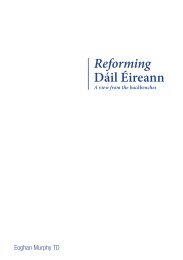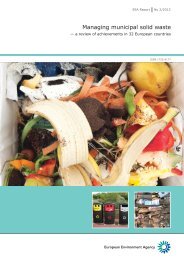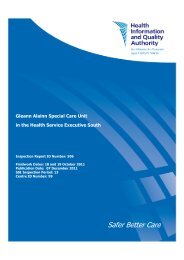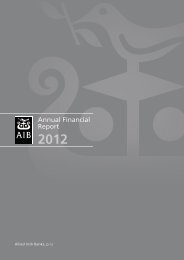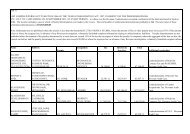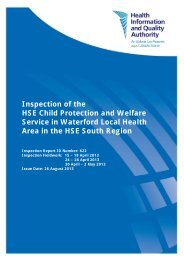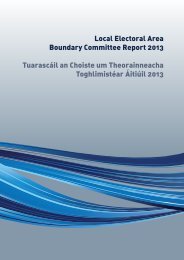HSE Child Protection and Welfare Service in Carlow/Kilkenny - hiqa.ie
HSE Child Protection and Welfare Service in Carlow/Kilkenny - hiqa.ie
HSE Child Protection and Welfare Service in Carlow/Kilkenny - hiqa.ie
You also want an ePaper? Increase the reach of your titles
YUMPU automatically turns print PDFs into web optimized ePapers that Google loves.
Inspection of the <strong>HSE</strong> <strong>Child</strong> <strong>Protection</strong> <strong>and</strong> <strong>Welfare</strong> <strong>Service</strong> <strong>in</strong> <strong>Carlow</strong>/<strong>Kilkenny</strong> Local Health Area <strong>in</strong> the<strong>HSE</strong> South RegionHealth Information <strong>and</strong> Quality Authoritychildren’s files on the electronic system <strong>and</strong> <strong>in</strong> hard copy <strong>and</strong> found that socialworkers had carr<strong>ie</strong>d out the assessment <strong>and</strong> completed the required documents.Where a student had undertaken direct work as part of the assessment process,<strong>in</strong>spectors saw that the supervis<strong>in</strong>g social worker had rev<strong>ie</strong>wed <strong>and</strong> co-signed thedocumentation. There was a tool <strong>in</strong> place to support the social workers’ assessment,<strong>and</strong> identif<strong>ie</strong>d risks were recorded on it as well as the actions to be taken.The <strong>in</strong>itial assessment process identif<strong>ie</strong>d children’s <strong>and</strong> famil<strong>ie</strong>s’ needs <strong>and</strong> strengths,as well as associated risks, but it was not robust. With<strong>in</strong> this process, social workersdeterm<strong>in</strong>ed positive elements with<strong>in</strong> the family structure to mitigate areas ofconcern. This process was central to the duty assessment function of the social workdepartment, but <strong>in</strong>spectors found it had shortcom<strong>in</strong>gs. No formal risk assessmenttool was used by social workers although the results of each assessment wererecorded on a st<strong>and</strong>ard form. There was a danger that social workers would notdeterm<strong>in</strong>e thresholds of harm consistently <strong>and</strong> this could then affect the prioritisationof referrals. The way <strong>in</strong> which the duty system was operated did not lend itself as aneffic<strong>ie</strong>nt assessment process.The assessment system was fragmented. In one social work office, social workerscompleted <strong>in</strong>itial assessments of some cases assigned to them by the social workduty team leader when work<strong>in</strong>g their three-day duty roster. However, if theassessment had not been completed at the end of this time, work on it ceased untilthe <strong>in</strong>dividual social worker returned to do a further duty assignment. In the othersocial work office, social workers were not assigned cases for assessment. Inspectorswere told that the focus of this system was for social workers to work the casesprioritised by the social work team leader on a day-by-day basis. This meant thateither several social workers could be <strong>in</strong>volved <strong>in</strong> the same assessment or thatassessments could take a considerable period of time.As previously stated, <strong>in</strong>itial assessments were not carr<strong>ie</strong>d out <strong>in</strong> the requiredtimeframes. Data provided to the Authority by the LHA showed <strong>in</strong> the 12 monthsprior to the <strong>in</strong>spection 1,156 referrals were received. Of these referrals the LHAdeterm<strong>in</strong>ed that 644 <strong>in</strong>itial assessments were recommended. Aris<strong>in</strong>g from thesereferrals, 266 were completed <strong>and</strong> a further 78 were ongo<strong>in</strong>g. Fifty-six werecompleted with<strong>in</strong> the timeframe recommended <strong>in</strong> <strong>Child</strong>ren First (2011).There was evidence that An Garda Síochána were <strong>in</strong>volved when there wereconcerns about a child, but not always at the appropriate stage as outl<strong>in</strong>ed <strong>in</strong><strong>Child</strong>ren First (2011) <strong>and</strong> the record<strong>in</strong>g of communications needed improvement.From documentation rev<strong>ie</strong>wed by <strong>in</strong>spectors, there were 33 formal notifications tothe Gardaí from the LHA between January 2012 <strong>and</strong> April 2012 <strong>and</strong> these had beenmade once an allegation of abuse had been confirmed. The notifications were part ofthe <strong>in</strong>teragency process outl<strong>in</strong>ed <strong>in</strong> <strong>Child</strong>ren First (2011). Inspectors were told thatthere was <strong>in</strong>formal communication between the social worker <strong>and</strong> An Garda Síochánafollow<strong>in</strong>g a report to the LHA when there were concerns about suspected physical orsexual abuse, or wilful neglect of a child. Inspectors found evidence that sometimesthese contacts were recorded but were concerned that this was not always the case.23



